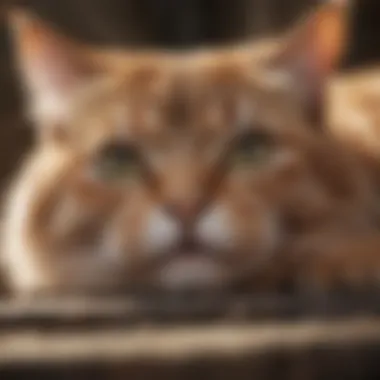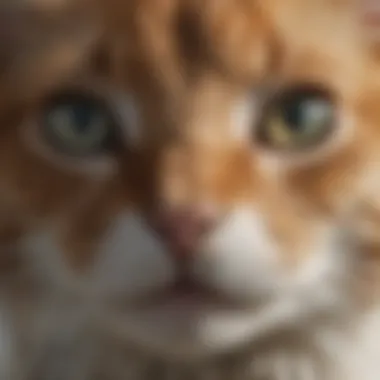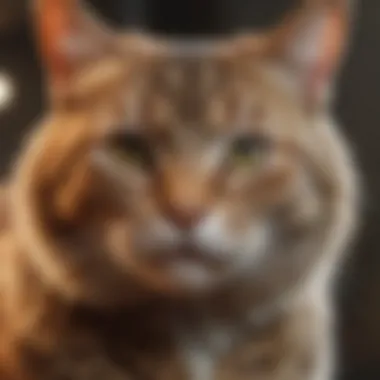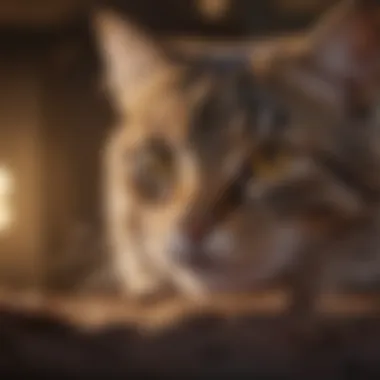Identifying Common Symptoms of Illness in Cats


Intro
Cats are inquisitive and independent creatures, but they can sometimes be elusive about their health. Recognizing symptoms of illness can be challenging for even the most attentive owners. This guide aims to dissect the various signs that indicate your feline may not be well, along with explaining their potential meanings. The insights gathered through this article will empower cat owners to take charge of their pet's health, enhancing the opportunity for timely interventions and better outcomes.
Understanding Your Pet
Understanding your cat goes beyond basic knowledge. Numerous factors influence a cat's health, including their breed traits, temperament, and any special needs they may have.
Breed Traits
Certain breeds exhibit specific health traits or predispositions. For instance, Siamese cats are known for respiratory issues, while Persians may develop kidney disease. Recognizing these traits can help owners monitor their pets more closely for any unusual behavior.
Common Temperaments
Cats, like people, have distinct temperaments. Some may be more outgoing while others prefer solitude. Knowing your cat's usual behavior is key. Sudden changes in mood or activity level can be early indicators that something is off. Watch for shifts in their energy levels, social interactions, or interest in play.
Special Needs
Older cats or those with chronic conditions often require more attention. This can include special diets or altered routines. Understanding these needs is crucial for maintaining their health.
Pet Care Essentials
Essential care for your cat helps lay the groundwork for their well-being. Areas to focus on include nutrition, grooming, and overall health maintenance.
Nutrition and Feeding Guidelines
Proper nutrition is foundational. Cats are obligate carnivores, meaning they require a diet high in meat. Look for high-quality cat foods that feature real meat as the first ingredient. A well-balanced diet can enhance your pet's immune system, helping to fend off illness.
Grooming Tips and Techniques
Regular grooming is essential, especially for long-haired breeds. This helps prevent matting and reduces shedding. Brushing your cat also allows you to check for lumps, parasites, or skin issues that could indicate health problems.
Health and Wellness
Routine veterinary check-ups also play a vital role. These appointments allow for early detection of potential health issues. Vaccinations and preventive care contribute significantly to keeping your cat safe.
Training and Behavior
Understanding your cat's behavior through training can significantly improve interactions and help prevent problems.
Basic Training Techniques
Simple commands can be taught using positive reinforcement. Reward your cat with treats or praise for desired behavior. Training sessions can help create a bond and establish routines that benefit their mental well-being.
Behavioral Problems and Solutions
If your cat exhibits troubling behaviors such as aggression or excessive vocalization, it is crucial to address these issues early. Identifying triggers may lead to solutions that improve your cat's comfort and your mutual relationship.
Mental Stimulation Activities
Providing mental stimulation is just as important as physical activity. Puzzles or toys that require problem-solving can keep your cat's mind sharp and engaged.
Engaging with Your Pet
Interaction with your cat is an important aspect of their well-being. Different activities can fortify your bond and aid in spotting health issues.
Interactive Games and Toys
Choosing engaging toys can create opportunities for play that also serve as exercise. Use feather wands or laser pointers judiciously to entice your cat into healthy activity.
Safe Outdoor Activities


For adventurous owners, leash training can provide safe outdoor explorations. Ensure the area is secure to avoid exposure to potential dangers.
Family-Friendly Pet Interactions
Educate all family members on gentle and respectful interactions with your cat. This minimizes stress for the pet and creates a harmonious living environment.
Pet Adoption and Integration
Bringing a new cat into your home requires some planning to ensure smooth integration.
Choosing the Right Pet for Your Lifestyle
Consider factors like activity level and grooming needs before adopting. This decision shapes the future relationship you and your pet will share.
Preparing Your Home for a New Pet
Prepare your environment with essential items such as a scratching post, litter box, and comfortable resting space. These preparations promote a smoother transition for your new companion.
Tips for Smooth Preamble
Introduce your existing pets gradually to the newcomer. Supervise initial interactions to identify any issues early on.
Timely identification of symptoms can be critical. Keep a vigilant eye on any changes in behavior or health of your cat.
Prolusion to Cat Health
Understanding cat health is vital for anyone who owns or plans to adopt a feline companion. Cats, despite their reputation for independence, rely on their owners to recognize when they are unwell. Monitoring their health can lead to quicker intervention, which is crucial for successful treatment.
Importance of Monitoring Health
The act of monitoring a cat’s health involves regular observation and assessment of their habits and behaviors. Pet owners should not only look out for visible signs of illness, but also make an effort to notice subtle changes in their cat’s routine. These changes can include shifts in eating habits, altered litter box usage, or variations in social interaction. Paying attention to these indicators can greatly accentuate the chances of spotting illness early.
Regularly scheduled veterinary check-ups enhance this monitoring process. A veterinarian can provide insights that owners may miss—such as slight weight changes or dental issues. Moreover, consistent health assessments build a rapport with a vet, ensuring a more thorough understanding of a cat’s unique health requirements.
When to Be Concerned
Understanding when to be concerned involves recognizing that not all changes signal a serious issue. However, some symptoms should raise immediate alarms. If a cat experiences excessive vomiting, a prolonged lack of appetite, or shows signs of severe lethargy, it may indicate an underlying health problem requiring timely medical intervention.
Always consult a veterinarian if you notice any alarming changes that persist more than a day or two.
It is essential to create a balance between being observant and not becoming overly anxious about every minor change. Some symptoms may be transient and not indicative of a serious condition. However, trust your instincts as a pet owner. If something feels off, it is prudent to seek professional guidance. Keeping a log of any concerning behaviors or changes can be helpful during veterinary visits to provide clear instances of what has been observed. By following these practices, cat owners can ensure better overall health for their pets.
Common Symptoms of Illness in Cats
Understanding the common symptoms of illness in cats is vital for any cat owner. Early detection of these symptoms can lead to prompt treatment, which maximizes the chances of recovery. Cats often hide their discomfort and pain, making it challenging to recognize when they are unwell. This section dissect various symptoms that can indicate an underlying health issue. Being vigilant about your cat's health allows you to take appropriate action when necessary, ensuring your pet's vitality and quality of life.
Changes in Appetite
A noticeable change in your cat's appetite can be a significant warning sign. Cats may either eat less or refuse food altogether when they are not feeling well. Conversely, increased appetite can also indicate illness, such as diabetes or hyperthyroidism. Monitoring your cat’s food intake is essential. Here are some things to consider:
- Decreased Appetite: This can lead to weight loss and further health complications.
- Increased Appetite: This may suggest metabolic disorders or other issues.
Reassess your cat’s eating habits and consult a veterinarian if you notice any alarming changes.
Behavioral Changes
Cats are creatures of habit, and any significant alteration in their behavior may indicate illness. Behavioral changes can manifest as increased aggression, withdrawal, or restlessness. A cat that suddenly seeks more attention or hides for long periods may be experiencing distress. It is crucial to observe their normal behavior closely so you can identify and act on changes. Note any unusual actions such as:
- Excessive Grooming: Could indicate stress or skin issues.
- Hiding: A sign that your cat may feel vulnerable or unwell.
These behavioral shifts can serve as critical clues for identifying health problems.


Vomiting and Diarrhea
Frequent vomiting or diarrhea is a common symptom of various ailments, ranging from dietary indiscretion to more severe issues like infections or organ failure. While a single instance may not be a significant concern, repeated occurrences require immediate attention. Look for additional signs such as:
- Blood in the Stool or Vomit: This is a serious sign that necessitates urgent veterinary care.
- Dehydration: Persistent vomiting and diarrhea can lead to severe dehydration, which is life-threatening without intervention.
Keep a close watch on your cat’s litter box habits, as these can provide useful information related to their health.
Lethargy or Weakness
Lethargy or sudden weakness can signal a range of issues, from infection to chronic diseases. A previously active cat that now sleeps excessively or avoids playtime should raise a flag. Assess your cat’s energy levels and compare them to their usual behavior. Important considerations include:
- Duration of Lethargy: Continuous weakness persisting over 24 hours warrants a veterinary evaluation.
- Other Symptoms: Accompanying signs such as vomiting or changes in appetite strengthen the case for seeking help.
Respiratory Distress
Respiratory distress manifests as difficulty breathing, coughing, or frequent swallowing. This may indicate a serious issue involving the lungs or airways. Symptoms to monitor include:
- Wheezing or Coughing: May signify infections or allergies.
- Open-Mouth Breathing: Indicates potential hypoxia, which requires immediate attention.
You should act quickly if your cat displays these symptoms to prevent fatal outcomes.
Limping or Difficulty Moving
Limping can stem from various causes, including injury, arthritis, or joint problems. Cats can be quite good at hiding discomfort, so look for subtle cues like avoidance of jumping, slowing down during playtime, or favoring one limb. Key points to consider are:
- Duration of Limping: If limping persists, visit a vet for assessment.
- Behavioral Changes: Changes in mobility may also indicate pain elsewhere in the body.
Weight Loss or Obesity
Sudden weight loss or unexpected weight gain can indicate underlying health conditions. A consistent weight change in your cat can be a warning signal of various diseases. Keep an eye on:
- Gradual vs. Rapid Changes: A slow and steady gain or loss might have different implications than sudden shifts.
- Body Condition: Regularly monitoring their weight can help in identifying abnormalities sooner.
Consult a veterinarian if you observe significant weight fluctuations.
Skin and Coat Issues
The quality of a cat's skin and coat is a reflection of overall health. Dry, flaky skin or excessive shedding may suggest underlying health issues. If you observe any of the following symptoms, take notice:
- Bald Patches or Inflammation: This could indicate infections or allergies.
- Dull Coat: A decrease in grooming behavior may suggest illness or discomfort.
Regular inspections and failing to overlook coat quality can lead to early diagnosis of potential health problems.
It is essential to remember that pets do not speak the human language. Observing their behaviors, appetite, and overall demeanor can provide critical clues to their health.
By paying close attention to these common symptoms, cat owners can take early action, leading to better health outcomes for their beloved pets.
Specific Illnesses Identified by Symptoms
Recognizing specific illnesses through their symptoms is crucial for timely veterinary care. When cats exhibit unusual behavior or health signs, understanding the potential underlying conditions can guide pet owners toward appropriate actions. Each illness has its unique symptoms that not only distinguish it from other health issues but also influence treatment decisions and outcomes. By realising the significance of these illnesses, pet owners enhance their ability to act swiftly and ensure their feline friends receive the best possible care.
Kidney Disease
Kidney disease often manifests gradually, making it hard to detect in initial stages. Common symptoms include increased thirst and urination, weight loss, and vomiting. As the disease progresses, cats may also show signs of lethargy and poor appetite. Recognizing these symptoms quickly is vital because early intervention can slow progression and improve your cat's quality of life. Blood tests and urinalysis can confirm kidney issues, allowing veterinarians to determine the most effective treatment plan.
Diabetes Mellitus
Diabetes Mellitus is a chronic condition often seen in overweight cats. Understanding the signs is key. Symptoms typically include excessive thirst, frequent urination, and noticeable weight loss despite a healthy appetite. Some cats may develop lethargy or a poor coat condition. Early diagnosis is beneficial as it allows for the management of the disease through dietary changes and insulin therapy. Knowing these symptoms can make a significant difference in your cat’s long-term health and wellbeing.
Hyperthyroidism


Hyperthyroidism is more common in older cats and arises from an overproduction of thyroid hormone. Symptoms include increased appetite, weight loss, hyperactivity, and vomiting. An affected cat may also have a noticeable increase in thirst and frequent urination. Detecting these symptoms early can help pet owners discuss treatment options with their vet. Potential treatments include medication, radioactive iodine therapy, or surgical intervention, depending on the severity of the condition.
Dental Disease
Dental disease is not just a dental issue; it can lead to systemic health problems if not addressed. Common signs include bad breath, difficulty eating, and swollen gums. Cats with dental disease may also exhibit changes in behavior. Routine dental check-ups and cleanings can prevent serious health issues. Being vigilant about oral health can lead to early detection and treatment, safeguarding your cat's overall health.
Feline Lower Urinary Tract Disease (FLUTD)
FLUTD encompasses various urinary tract issues that can affect cats of any age. Symptoms often include straining to urinate, frequent trips to the litter box, or blood in urine. Cats may also display signs of distress such as yowling or vocalizing when attempting to urinate. Recognizing these symptoms is critical as FLUTD can lead to severe complications like blocked urethra, which requires immediate veterinary attention. A swift response can make all the difference in ensuring the wellbeing of your pet.
General Care Tips for Ill Cats
Taking care of an ill cat requires a thoughtful approach from pet owners. Recognizing symptoms of illness is the first step, but general care is equally crucial. This section emphasizes key aspects of care that can help improve a cat's health and facilitate recovery. These tips encompass routine veterinary visits, adjustments in diet, and effective stress management techniques.
Regular Veterinary Check-Ups
Regular veterinary check-ups are an essential part of monitoring your cat's health. Just as humans benefit from routine health assessments, cats need the same level of attention. These visits allow veterinarians to identify potential health issues before they escalate. During these check-ups, the veterinarian can conduct thorough examinations, recommend vaccinations, and perform necessary tests.
It is advisable to schedule these check-ups at least once a year. Older cats or those with pre-existing health issues might require more frequent visits. Establishing a good relationship with the vet can also make the process easier for both the pet and the owner. In addition, any concerns raised during the visit can lead to early interventions, a crucial factor in the successful treatment of various conditions.
Dietary Adjustments
Diet plays a significant role in maintaining health for an ill cat. Specific dietary adjustments can promote recovery and overall well-being. Depending on the cat’s symptoms or particular illness, owners should discuss with their vet about creating a diet plan suitable for their needs. This may involve changing the type of food or its nutritional composition.
For example, a cat suffering from kidney disease might benefit from a low-protein diet, while a diabetic cat needs consistent carbohydrate levels. Providing fresh water is also important. A well-hydrated cat is less prone to urinary issues and other complications. Monitoring the cat's eating habits can reveal patterns or concerns that need addressing.
Stress Management Techniques
Stress can exacerbate health issues in cats and hinder recovery. Providing a calm and secure environment is crucial. Pet owners should consider various stress management techniques to enhance their cat's comfort. Keeping a consistent routine helps reduce anxiety. Cats thrive on predictability.
Furthermore, creating a quiet space can provide a refuge for an ill cat. Utilizing calming products, such as pheromone diffusers or specific toys, can also be helpful. Engaging in gentle play or offering comfort with petting can reassure the cat, fostering a sense of safety. Keeping an eye on changes in behavior related to stress is vital, as it may indicate further health issues.
Taking proactive steps in your cat's care can make a significant difference in their health trajectory.
Recognizing Emergency Situations
Recognizing emergency situations is a critical component when assessing cat health. Being able to discern when a cat's condition requires immediate veterinary attention can significantly influence treatment outcomes and possibly save lives. Many pet owners may not fully grasp the urgency of certain symptoms, leading to delayed intervention that can worsen the situation. This section provides guidance on identifying such scenarios and the actions needed to take, emphasizing the significance of prompt medical care.
When to Seek Immediate Vet Care
Several specific signs indicate that a cat may need immediate veterinary attention. Ignoring these symptoms can lead to serious health repercussions. Some key indicators include:
- Severe vomiting or diarrhea: Frequent vomiting or diarrhea lasting more than 24 hours, especially if it is accompanied by blood.
- Difficulty breathing: Any signs of labored or rapid breathing should be addressed without delay.
- Unconsciousness or severe disorientation: If a cat is not responsive or exhibits unusual behavior, this can be a sign of a serious issue.
- Severe bleeding: Any injury that leads to significant blood loss requires urgent care.
- Seizures: If a cat has a seizure that lasts more than a few minutes or has multiple seizures in a short period.
- Uncontrollable pain: If a cat cries out in pain or avoids being touched, it’s important to seek help right away.
Always keep in mind that being cautious is better than risking your cat’s health. If you are unsure whether a situation is an emergency, it is always best to contact a veterinarian for advice.
Signs of Severe Distress
Recognizing signs of severe distress is vital for the well-being of a cat. Understanding these signs can alert you to potential emergencies, allowing for quick action. Some prominent signs to look for include:
- Extreme lethargy: A dramatic decrease in activity that is not typical for your cat.
- Trembling or agitation: Visible shaking or unusual restlessness can be a red flag.
- Change in vocalization: Unusual crying or howling could indicate distress.
- Hide away: If your cat suddenly seeks out secluded areas and avoids interaction, this is concerning.
- Refusal to eat or drink: If your cat goes more than a day without eating or drinking, prompt evaluation is important.
Immediate recognition of severe distress ensures timely intervention, which can be life-saving for your cat.
While this guide outlines common emergency signs, each cat may have unique behaviors. Therefore, paying attention to your cat’s usual habits is essential. Early recognition and action can improve health outcomes significantly.
Ending
Recognizing the symptoms of illness in cats is critical for any cat owner. Understanding these signs can lead to early detection of health issues, making the difference between a mild illness and a serious condition. When cat owners know what to look for, they can act swiftly, leading to better outcomes for their pets.
Summary of Key Points
Several key symptoms indicate that a cat may be unwell. These include:
- Changes in appetite can signal an underlying health issue.
- Behavioral changes like increased aggression or withdrawal may point to discomfort or distress.
- Vomiting and diarrhea are red flags that should not be ignored.
- Lethargy or unusual weakness can indicate various illnesses.
- Respiratory distress can be life-threatening, demanding immediate attention.
- Limping or difficulty moving is often tied to pain or injury.
- Weight loss or sudden obesity changes may reflect metabolic disorders.
- Skin and coat issues can hint at allergies or systemic problems.
The Importance of Timely Action
Taking prompt action when these symptoms arise cannot be overstated. Ignoring subtle signs may lead to the progression of disease, making treatment more complex. Timely veterinary interventions can lead to quick diagnoses, successful treatment plans, and ultimately, a stronger chance of recovery for a beloved pet. Being vigilant and proactive in monitoring cat health ensures a better quality of life for these animals. Regular check-ups and awareness of changes are essential steps toward maintaining feline health and well-being.



